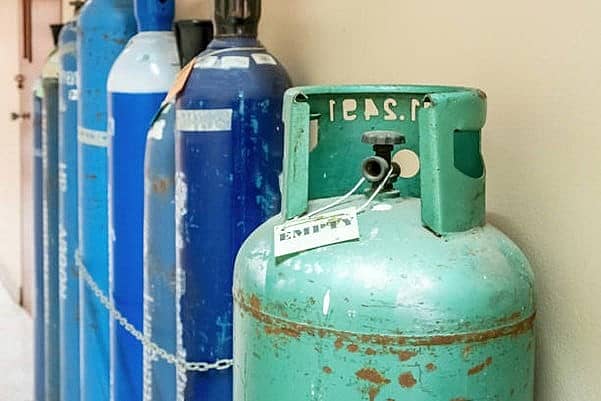Improper storage of gas cylinders can be very hazardous because the compressed gas is under high pressure. The pressure is generally sufficient to forcefully propel the cylinder in the case of sudden pressure release. A sudden release of compressed gas can cause a cylinder to become a missile-like projectile and cylinders have been known to penetrate cinderblock walls!
The Compressed Gas Association and NFPA 1 require that compressed gas cylinders be secured to prevent them from falling or being knocked over by securing them to a fixed object like a bench or wall, by use of a restraint such as a chain, strap, or bracket.
One of the most common issues we see is two or more gas cylinders being secured to a wall bracket made only for one cylinder. There are a few options for storage alternatives. If wall space allows, a bracket designed for up to four standard-size cylinders could be used. If there are wall space constraints, another option is to purchase a gas cylinder storage rack. These come in various sizes and the larger models can store up to 12 standard size cylinders.
A common misconception is that the nesting of gas cylinders is an acceptable means of securing them. Nesting is defined as each cylinder having three points of contact with either a wall or other gas cylinders. However, per NFPA 1, the nesting of gas cylinders is only allowed at gas distributors, filling facilities, or sellers’ warehouses, so it is not appropriate for storage in laboratories.
Some other reminders to ensure safe gas cylinder storage:
- Attach chains or straps used to secure cylinders 2/3 of the way up on the cylinder
- Do not remove cylinder caps while the cylinder is in storage as they protect the valve on the top of the cylinder from damage if it’s knocked over
- Place cylinders in a location where they will not be subject to mechanical or physical damage, heat, or electrical circuits to prevent possible explosion or fire
- Segregate cylinders into hazard classes while in storage. Oxygen and other oxidizers must be separated from flammable gases or combustible materials by a minimum distance of 20 feet or by a non-combustible barrier at least five feet high with a fire-resistance rating of at least one-half hour
- Store gases in the order in which they are received and will be used
- Segregate empty cylinders from full cylinders
One last reminder, don’t forget that small lecture bottle gas cylinders need to be properly stored too to protect them from damage, corrosion, and leaks. They should be stored in an upright position using an appropriate lecture cylinder stand. For additional information on safe gas cylinder storage, please email us at [email protected].
This blog was written by Beth Graham, our Associate Director of Quality, Research, and Training.


